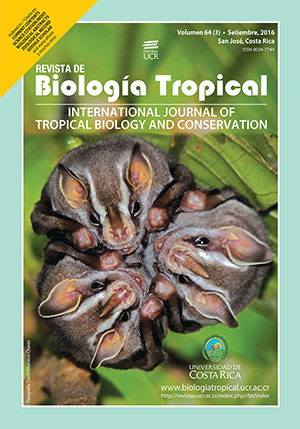Resumen
Después de un estudio más general sobre la historia natural y la comunicación por vibraciones de sustrato del membrácido Ennya chrysura, este artículo explora con mayor profundidad los comportamientos específicamente relacionados con el cuido de los huevos. En condiciones naturales (San Antonio de Escazú, Costa Rica), las hembras de E. chrysura con frecuencia protegen sus masas de huevos, y el cuido está asociado con un menor porcentaje de parasitismo causado por las avispas parasitoides de huevos Gonatocerus anomocerus and Schizophragma sp. (Mymaridae). Las hembras tendían a poner sus huevos en la cercanía de otras hembras con huevos, y producían vibraciones de sustrato en respuesta a disturbios. Se confirmó un patrón agregado bajo condiciones naturales, calculando índices de dispersión a partir del número de masas de huevos en 66 hojas. La señal fue descrita a partir de grabaciones hechas en el laboratorio con 10 hembras que protegían sus huevos. Los experimentos conducidos con 18 hembras mostraron que aquellas que fueron expuestas a la señal de disturbio de otra hembra, se movieron ligaramente o vibraron más durante el experimento, y reaccionaron a un estímulo táctil más rápidamente y con un mayor número de comportamientos defensivos. Las señales producidas durante la defensa de huevos podrían entonces funcionar como alarma, y favorecer la agrupación con otras hembras que también protegen sus huevos.
Citas
Avisoft Bioacoustics. (2002). Hardware and Software for Investigating Animal Acoustic Communication. Berlin: Avisoft-SASLab Pro Sound Analysis and Synthesis Software. Retrieved from http://www.avisoft.com/soundanalysis.htm
Blumstein, D. T., Evans, C. S., & Daniel, J. C. (2000). Jwatcher 0.9 An Introductory User´s Guide. Australia: Animal Behaviour Laboratory, Macquarie University.
Buchler, E. R., Wright, T. B., & Brown, E. D. (1981). On the functions of stridulation by the passalid beetle Odontotaenius disjunctus (Coleoptera: Passalidae). Animal Behaviour, 29, 483-486.
Camacho, L., Keil, C., & Dangles, O. (2014). Factors influencing egg parasitism in sub-social insects: insights from the treehopper Alchisme grossa (Hemiptera, Auchenorrhyncha, Membracidae). Ecological Entomology, 39, 58-65.
Claridge, M. F. (1985). Acoustic signals in the Homoptera: behavior, taxonomy, and evolution. Annual Review of Entomology, 30, 297-317.
Cocroft, R. B. (2003). The social environment of an aggregating, ant-attended treehopper (Hemiptera: Membracidae: Vanduzea arquata). Journal of Insect Behavior, 16, 79-95.
Cocroft, R. B., & Rodríguez, R. L. (2005). The behavioral ecology of insect vibrational communication. Bioscience, 55, 323-334.
Cocroft, R. B., & McNett, G. D. (2006). Vibratory Communication in Treehoppers (Hemiptera: Membracidae). In S. Drosopoulos & M. F. Claridge (Eds.), Insect Sounds and Communication: Physiology, Behaviour, Ecology and Evolution (pp. 305-317). London: CRC Press.
Cocroft, R. B., & Hamel, J. A. (2010). Vibrational communication in the “other insect societies”: A diversity of ecology, signals, and signal functions. In C. O’Connel-Rodwell (Ed.), The use of vibrations in communication: properties, mechanisms and function across taxa (pp. 7-41). India: Research Signpost.
Cocroft, R. B., Rodríguez, R. L., & Hunt, R. E. (2010). Host shifts and signal divergence: mating signals covary with host use in a complex of specilized plant-feeding insects. Biological Journal of the Linnean Society, 99, 60-72.
Cocroft, R. B., Hamel, J. A., Su, Q., & Gimson, J. (2014). Vibrational Playback Experiments: Challenges and Solutions. In R. B. Cocroft, M. Gogala, P. S. M. Hill, & A. Wessel (Eds.), Studying Vibrational Communication (pp. 248-274). Berlin: Springer-Verlag.
Eberhard, W. G. (1986). Possible mutualism between females of the subsocial membracid Polyglypta dispar (Homoptera). Behavioral Ecology and Sociobiology, 19, 447-453.
Godoy, C., Miranda, X., & Nishida, K. (2006). Treehoppers of tropical America. Costa Rica: National Institute of Biodiversity.
Klump, G. M., & Shalter, M. D. (1984). Acoustic behavior of birds and mammals in the predator context: I. Factors affecting the structure of alarm signals, II. The functional significance and evolution of alarm signals. Zeitschrift fur Tierpsychologie, 66, 189-226.
Krebs, C. J. (1999). Ecological Methodology. California: Addison-Wesley Educational Publishers Inc.
Lin, C. P. (2006). Social behaviour and life history of membracine treehoppers. Journal of Natural History, 40, 1887-1907.
Marshall, D. C. (2000). Behavior and evolution of periodical cicadas (Magicicada spp.) (Ph.D. dissertation). University of Michigan, Michigan, USA.
Masters, W. M. (1979). Insect disturbance stridulation: its defensive role. Behavioral Ecology and Sociobiology, 5, 187-200.
Miranda, X. (2006). Substrate-borne signal repertoire and courtship jamming by adults of Ennya chrysura (Hemiptera: Membracidae). Annals of the Entomological Society of America, 99, 374-386.
Morales, M. A., Barone, J. L., & Henry, C. S. (2008). Acoustic alarm signalling facilitates predator protection of treehoppers by mutualist ant bodyguards. Proceedings of the Royal Society, 275, 1935-1941.
Stegmann, U. E., & Linsenmair, K. E. (2002). Subsocial and aggregating behaviour in Southeast Asian treehoppers (Homoptera: Membracidae: Centrotinae). European Journal of Entomology, 99, 29-34.
Syntrillium Software Corporation. (1999). Cool Edit Pro Version 1.2 User Guide Addendum. Syntrillium Software Corporation. Retrieved from http://www.inventati.org/akusmatik/base/tutorials/manual/cep12add.pdf
Wong, J. W. Y., Meunier, J., & Kölliker, M. (2013). The evolution of parental care in insects: the roles of ecology, life history and the social environment. Ecological Entomology, 38, 123-137.
Wood, T. K. (1984). Life history patterns of tropical membracids (Homoptera: Membracidae). Sociobiology, 8, 299-344.
Wood, T. K. (1993). Diversity in the New World Membracidae. Annual Review of Entomology, 38, 409-35.
Zar, J. H. (1996). Biostatistical Analysis (3rd ed). New Jersey: Prentice-Hall.
##plugins.facebook.comentarios##

Esta obra está bajo una licencia internacional Creative Commons Atribución 4.0.
Derechos de autor 2016 Revista de Biología Tropical






